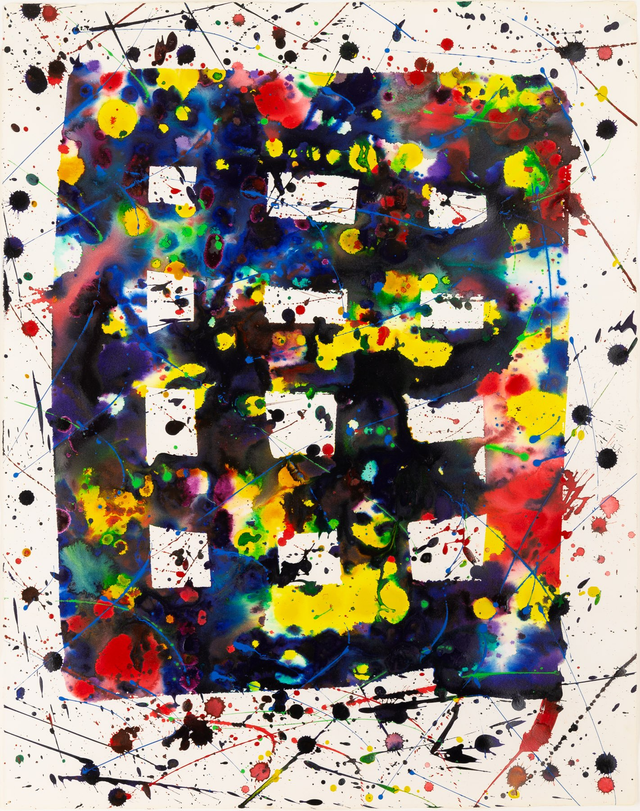Sam Francis
American abstract painter Sam Francis is renowned as a leading figure among post-World War II abstract expressionists. He amassed a prolific body of work, encompassing thousands of paintings, works on paper, prints, monotypes, lithographs, and sculptures.
Biography of Sam Francis
Sam Francis was born in San Mateo, California, in the early 1920s. Initially drawn to music during his childhood, his passion for visual arts blossomed in later years. An inherently curious individual, Francis exhibited interests in visual arts, botany, medicine, and psychology.
Before attaining his BA and MA degrees in natural sciences, he served in the United States Air Force, where he was injured during test flights. It wasn't until the 1950s that Francis completed his studies at the University of California, Berkeley. Following graduation, he relocated to Paris, swiftly gaining recognition as the most promising American painter in the city.
This period marked a significant turning point in his career as he immersed himself in the works of renowned masters, such as Monet's "Water Lilies." Over the subsequent four decades, Francis embarked on extensive travels and maintained studios in Bern, Tokyo, Mexico City, and his hometown.
From the 1950s, his work underwent several transformative stages, beginning with monochromatic abstractions and progressing to vibrant, large-scale murals and paintings featuring large negative space areas. Following the inclusion of his 1953 painting "Big Red" in the 1956 exhibition "Twelve Artists" at the Museum of Modern Art (MOMA) in New York, Francis gained international recognition. He further solidified his reputation by creating large murals for the Kunsthalle in Basel in 1956 and the Chase Manhattan Bank in 1959.
In the early 1960s, Sam Francis embarked on several series of works, including his renowned Blue Balls series. These paintings predominantly featured round forms and drips, serving as abstract references to the artist's suffering from renal tuberculosis in 1961.
In addition to his dedication to canvas-based works, Francis was recognized as a prolific printmaker, producing numerous etchings, lithographs, and monotypes. In 1984, he established The Lapis Press group, aiming to produce visually compelling formats for unusual texts, showcasing his interest in graphic design and typography.
The artist also delved into sculpture and sculpture drawings, many of which were created during his time in Japan and drew inspiration from simple classical forms. Exhibited in 1966 at the Minami Gallery in Tokyo and a year later at the San Francisco Museum, these sculpture drawings showcase Francis's ability to convey movement and energy through geometric forms. This exploration of three-dimensional works continued beyond the 1960s, with Francis deciding in 1979 to cast some of his drawings into three-dimensional works. Utilizing chromed steel for its light-reflecting properties, Francis enhances the sculptures' clean energy and aesthetic appeal.
Due to his extensive work and exhibitions across the United States, Europe, and Asia, Sam Francis is recognized as one of the foremost international post-war painters. His exhibitions were predominantly held in Europe and Japan.
Throughout his lifetime, the artist was featured in 113 solo exhibitions in various museums and galleries, with an additional 90 solo exhibits following his death in 1994. His paintings adorn esteemed international museum collections such as the Metropolitan Museum and the Museum of Modern Art (MOMA) in New York, the Kunstmuseum in Basel, Switzerland, the Idemitsu Museum of Arts in Tokyo, and the Centre Pompidou. Continuously sought after, Francis's work commands high value at auctions.
A pioneer in investing in non-renewable energy sources and researching cures for AIDS, he remained at the forefront of innovation. Towards the end of his life, the artist battled prostate cancer and faced challenges with his right hand following an injury, limiting his ability to paint or edit. Despite these obstacles, he summoned his remaining energy to complete an extraordinary series of 150 small paintings before his passing in Santa Monica. Sam Francis was laid to rest in Olema, Marin County, California.
The Sam Francis Foundation was established shortly after the artist died in 1994. Its primary mission is to research, document, and preserve the artistic legacy of Sam Francis while promoting his significant works through various channels, including education, online platforms, and social networks.
Sam Francis's Art Style
Renowned for his lyrical and gestural prowess, Sam Francis had a unique ability to imbue his work with the vibrancy, energy, and intensity of colors in a highly individualized manner. His paintings reflected his deep appreciation for literature, music, and science, conveying a wide spectrum of emotions. Francis approached the creative process holistically, addressing not only artistic issues but also engaging with technology, psychology, science, and medicine in his projects.
During his extensive travels, Francis encountered diverse styles, techniques, and cultural influences that accelerated his artistic development. His artistic evolution was greatly influenced by his exposure to French modern painting and Zen Buddhism during his time in Japan.
The central elements at the core of Sam Francis' work have consistently been light and space. While the concept of light and space in painting is not novel, what sets Francis apart is his distinctive interpretation of the perpetual interplay between light and space, not only within traditional paintings but also in alternative three-dimensional pieces.
Years:
Born in 1923
Country:
United States of America, San Mateo, California
Gallery:
Galleria d'Arte Maggiore g.am.
Galerie Carzaniga Basel
Bernard Jacobson Gallery
Christopher-Clark Fine Art



